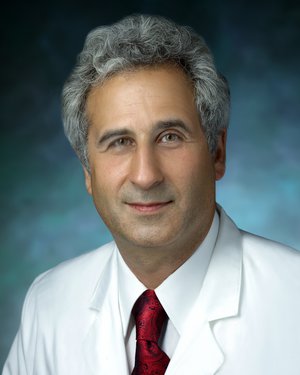Patient Story
Fetal Hypothyroidism and Goiter: The Carters’ Story

Patient Story Highlights
- Kristy Purtell-Carter and her husband, De Carter, found out that their unborn son, Myles, had developed a mass on his neck.
- They sought help from Ahmet Baschat, M.D., at Johns Hopkins, who diagnosed hypothyroidism and a goiter.
- The Johns Hopkins Center for Fetal Therapy coordinated with health care providers near the couple’s home so Myles could be treated in utero.
Kristy Purtell-Carter and her husband, De Carter, gazed upon their unborn son’s 20-week ultrasound with familiar amazement. The Carters had two other children and expected to find Myles in good health.
But this time, the ultrasonographer left the room and came back with a doctor. The imaging had revealed something unexpected: an abnormality near Myles’ neck. The next week, the Carters sought help from a perinatologist close to their home in Fredericksburg, Virginia.
Kristy had a bad feeling. “I don’t know if I was being paranoid or protective,” she says.
Rounds of imaging revealed the irregular mass on Myles’s neck was non-cancerous, which was comforting, but only to a point. It was growing at an alarming rate, and without an obvious cause.
“It was surreal,” recalls Kristy.
The Turning Point: A Diagnosis and a Plan
Then her doctor referred her to Ahmet Baschat, M.D., director of the Johns Hopkins Center for Fetal Therapy.
“Going to Baltimore was a big hike, but I knew we wanted the best hands,” says Kristy. “And I was terrified, of course. Up to that point, every time I went to the doctor’s office, I was always given bad news: that the mass was still growing and no one seemed to know what it was. [Baschat] was my last hope.”
Finally, after weeks of wondering, Kristy found the answers she needed. The fetal therapy team tested Myles’ thyroid and discovered he had hypothyroidism. The mass in his neck was the enlarged thyroid gland — a congenital (inborn) goiter. The condition is rare, occurring once in every 40,000 deliveries worldwide.
Baschat explains: “Myles’ goiter was caused by his thyroid gland not producing enough thyroid hormone. Due to this deficiency, the brain releases thyroid stimulation hormone [TSH]. When the thyroid is stimulated by TSH to produce more thyroid hormone but does not do so, the hormone precursors accumulate in the gland and make it swell, leading to goiter.”
Baschat says treating the fetus with external thyroid hormone helps to resolve the goiter, which is important since a goiter can partially obstruct the airway, making it hard for the baby to breathe independently when born. A technique called ex-utero intrapartum treatment (EXIT), may be necessary at birth.
“Many fetuses with goiter can actually have a normal developmental outcome, because the gland is able to produce some thyroid hormone,” Baschat says.
I had gone to five other hospitals when we were deciding what to do. Dr. Baschat was the only one who said he’d seen this before.
Kristy Purtell-Carter
Help for Myles from a Skilled Team
Once the Johns Hopkins team had identified the cause of Myles’ neck mass, it needed the right treatment plan.
“I had lots of questions about the treatment,” Kristy remembers. “It’s frustrating when no one has heard of your child’s condition. I had gone to five other hospitals when we were deciding what to do. Dr. Baschat was the only one who said he’d seen this before.”
Thyroid medicine would need to be injected into the amniotic fluid and the umbilical cord to regulate Myles’ thyroid and shrink the goiter.
Baschat met with Kristy and De to put together a treatment plan that would accommodate their family. Living four hours from The Johns Hopkins Hospital made weekly appointments a challenge.
“Our team performed the blood testing of the fetus and the first intra-amniotic fluid administration of thryroxine, a thyroid hormone,” Baschat explains. “The rest of the weekly intra-amniotic injections were done by her [local doctor] while we remained in regular contact with her. That way, we were able to manage the disease with Ms. Purtell only requiring three visits to the center.”
Kristy appreciated the team approach. “If my local doctor had any questions, the Johns Hopkins people would respond within hours,” she says.

Baby Myles arrives
The team approach to treatment helped Myles get better, and made it easier for Kristy to plan his delivery close to home. Baschat worked with her local provider to ensure everyone on her care team was prepared.
Their preparation soon paid off. At 36 weeks, Kristy went into labor after receiving an amniotic fluid injection. Though she had hoped for a vaginal delivery, Myles was born safely by cesarean section on Aug. 26, 2017. Baschat stayed in contact with Kristy’s local obstetric team throughout.
As for Myles, he had plenty to say. “He came out screaming when they didn’t think he would scream,” Kristy remembers.
After a long ordeal, the drive home from the local hospital felt right: a familiar route, a healthy baby and two joyous parents. With a team of providers working together with Kristy and De, Myles overcame a rare diagnosis. Today, with daily medication maintenance, the little boy is living the childhood his parents wanted for him.





